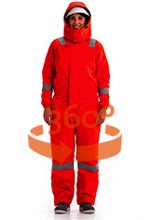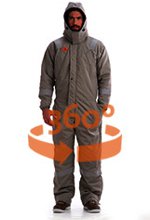THERMAL FR COVERALL
This product not only protects you from arc flash and flash fire but also from low temperatures including strong wind.
It also provides you comfort and freedom to move thanks to the use of THERMOFILL®, a technical hypoallergenic and self-extinguished wadding that is 50% more compacted than regular ones, without losing its great thermal properties. To guarantee the durability of the coverall, the wadding is diamond quilted to its linning.
It has a removable and adjustable hood suitable for the use with helmet. Two-way zipper protected by a flap with snap closure. Chest pockets and patch pocket in each leg. Elasticized waist and cuffs. Zipper in both pant-cuffs. Triple stitched and bar tacked with FR thread to provide a better tear and fire resistance.
Outer shell: an FR fabric of your choice
Wadding: THERMOFILL®
Linning: 100% cotton or FR fabric of your choice.
FR reflective tapes and X-PORE® for water resistant property can be added under special request.
It has a removable and adjustable hood suitable for the use with helmet. Two-way zipper protected by a flap with snap closure. Chest pockets and patch pocket in each leg. Elasticized waist and cuffs. Zipper in both pant-cuffs. Triple stitched and bar tacked with FR thread to provide a better tear and fire resistance.
Outer shell: an FR fabric of your choice
Wadding: THERMOFILL®
Linning: 100% cotton or FR fabric of your choice.
FR reflective tapes and X-PORE® for water resistant property can be added under special request.

American standard which establishes that employees who are exposed to a possible arc flash should wear appropriate flame resistant garment for the risk level of their workplace. Employers must evaluate an arc flash to determinate the risk of potential energy and the limit of protection against the arc flash.
The protective garment should cover the calculated incident energy or risk level, reaching at least its minimum ATPV.
Arc Thermal Performance Value - ATPV
Arc Thermal Performance Value - ATPV
- Level 0: No risk
- Level 1: between 4 to 7.9 cal/cm2
- Level 2: between 8 to 24.9 cal/cm2
- Level 3: between 25 to 39.9 cal/cm2

American standard for garments that protect from flash fire. The standard demands that after being washed a hundred times, the garment is put on a mannequin and exposed to 3 seconds of direct flame. In order to accomplish the standard the result must show less than 50% of body burn.

For Molten aluminium splashes (code D) the garment must classify at least at level D1.
Molten iron splashes (code E) the garment must classify at least at level E1
Level |
Molten Aluminium (g) |
|
Min. |
Max. |
|
D1 |
100 |
< 200 |
D2 |
200 |
< 350 |
D3 |
350 |
|
Level |
Molten iron (g) |
|
Min. |
Max. |
|
E1 |
60 |
< 120 |
E2 |
120 |
< 200 |
E3 |
200 |
|

The standard classifies High-Visibility Safety Apparel (HVSA) as Performance Class 1, 2 or 3, depending on the amount of visible background and retroreflective material. These Performance Classes give users a way to specify HVSA that is appropriate for the work environment and hazards. The 2015 edition also establishes three types of garments:
- Type O (off-road), for non-roadway use, where workers are not exposed to high traffic or temporary control zones. Type O HVSA is Performance Class 1.
- Type R (roadway), for use where workers are exposed to traffic from public access highway rights-of-way or roadway temporary control zones. Type R HVSA may be Performance Class 2 or 3.
- Type P (public safety) for emergency and incident responders and law enforcement personnel who are exposed to struck-by hazards in roadway or off-road work environments. These garments provide additional options addressing competing hazards or the need for access to special equipment. Type P HVSA may be Performance Class 2 or 3






 ©Copyright 2015 Geotex SRL
©Copyright 2015 Geotex SRL